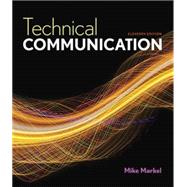Instructors know that Mike Markel’s Technical Communication will prepare their students for any workplace writing situation. No other text offers such a comprehensive introduction to the field while still delivering practical, effective support for students at every level. The eleventh edition has been thoroughly revised to reframe the work of technical communicators in the context of today’s highly collaborative, rapidly evolving digital practices. Fresh, social-media driven sample documents and coverage of the latest tools and technologies ensure that students work with the kinds of processes and products they’ll encounter on the job.
The text is now accompanied and enhanced by LaunchPad for Technical Communication, an online course space with an interactive e-book, multimedia sample documents for analysis, tutorials on digital writing tools, a new test bank, Learning Curve adaptive quizzes that give students more ways to master the material, and much more. Get all our great course-specific materials in one fully customizable space online; then assign and mix our resources with yours.







